Police allow six tents to protesters in front of Chicago Public Schools for overnight vigil of the 'dispossessed' opposing Renaissance 2010
Could a protest on a cold winter night in Chicago against an educational privatization plan backed by one of America's most powerful politicians and some of the nation's biggest corporations succeed?
If grass roots organizing and an alliance of teachers, students, parents, grandparents, and community leaders in defense of public schools were behind the protest, then the event was growing throughout the night of February 24 - 25, 2009, promising that a larger protest would echo through the city's downtown and inside the headquarters of its Board of Education on February 25.
By 9:00 p.m. on February 24, 2009, Chicago Police and leaders of protests against the Chicago Board of Education's "Renaissance 2010" program had reached an agreement. Protesters could place six tents along the east side of Clark St. in front of the Board's headquarters at 125 S. Clark St. in Chicago.
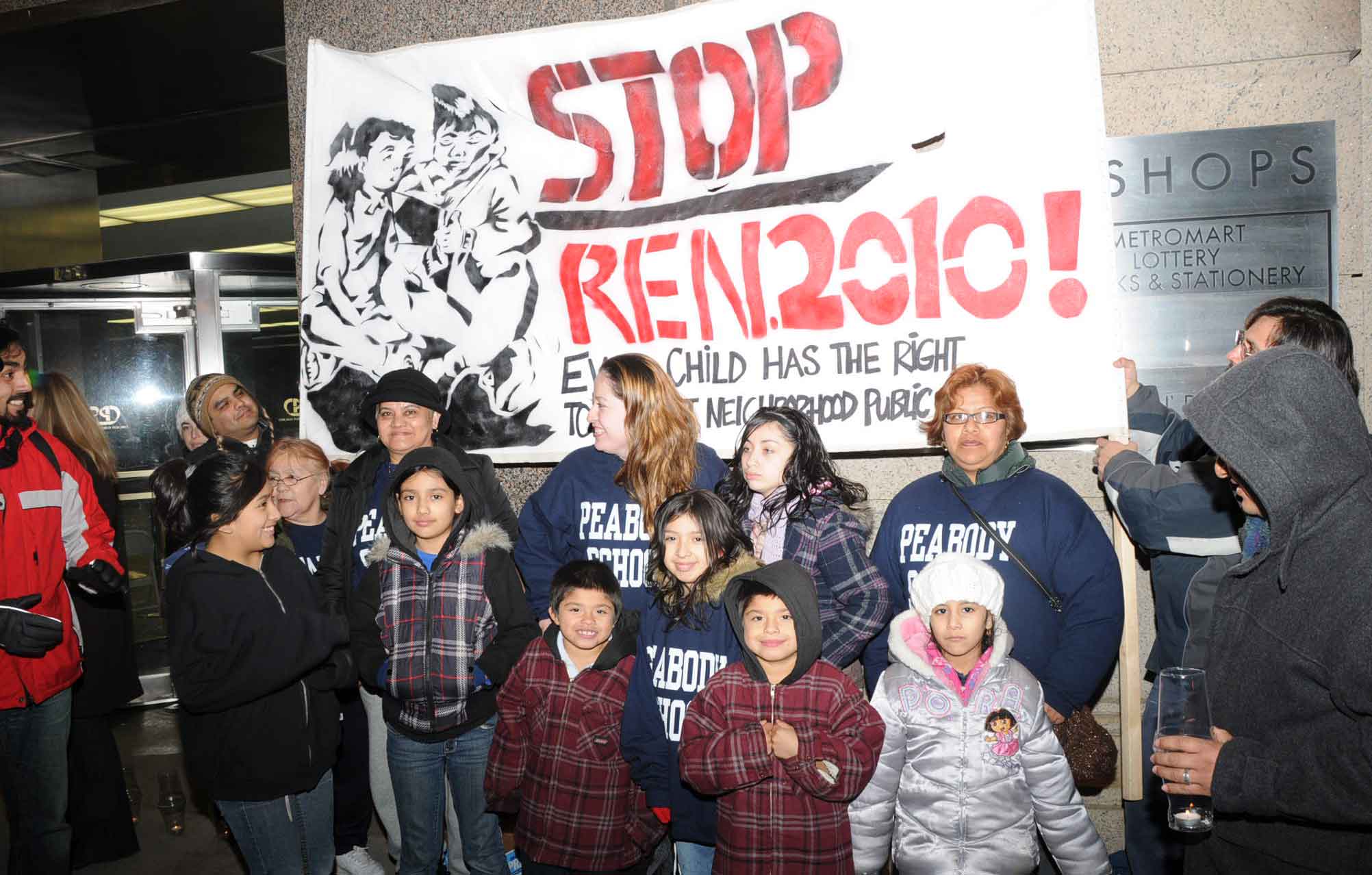 A cheer went up at 125 S. Clark St. in Chicago when the contingent from Peabody Elementary School arrived for the night of vigil and protest. Even though Peabody had been spared by an announcement the night before, Peabody grandparents, parents, teachers and children said they would continue their protests in support of the 16 school still on what protesters called the 'Hit List'. Substance photo by George N. Schmidt.Although the discussions between police and protesters had been cordial, there was worry in the crowd that Chicago's powerful mayor, Richard M. Daley, would order police and others to block the growing movement against one of his pet programs -- Renaissance 2010. Renaissance 2010 has been viewed by the majority of public school parents, teachers, and students across Chicago as an attack on public education and a force for privatization since it began under former Chicago Schools CEO Arne Duncan in the early years of the decade.
A cheer went up at 125 S. Clark St. in Chicago when the contingent from Peabody Elementary School arrived for the night of vigil and protest. Even though Peabody had been spared by an announcement the night before, Peabody grandparents, parents, teachers and children said they would continue their protests in support of the 16 school still on what protesters called the 'Hit List'. Substance photo by George N. Schmidt.Although the discussions between police and protesters had been cordial, there was worry in the crowd that Chicago's powerful mayor, Richard M. Daley, would order police and others to block the growing movement against one of his pet programs -- Renaissance 2010. Renaissance 2010 has been viewed by the majority of public school parents, teachers, and students across Chicago as an attack on public education and a force for privatization since it began under former Chicago Schools CEO Arne Duncan in the early years of the decade.
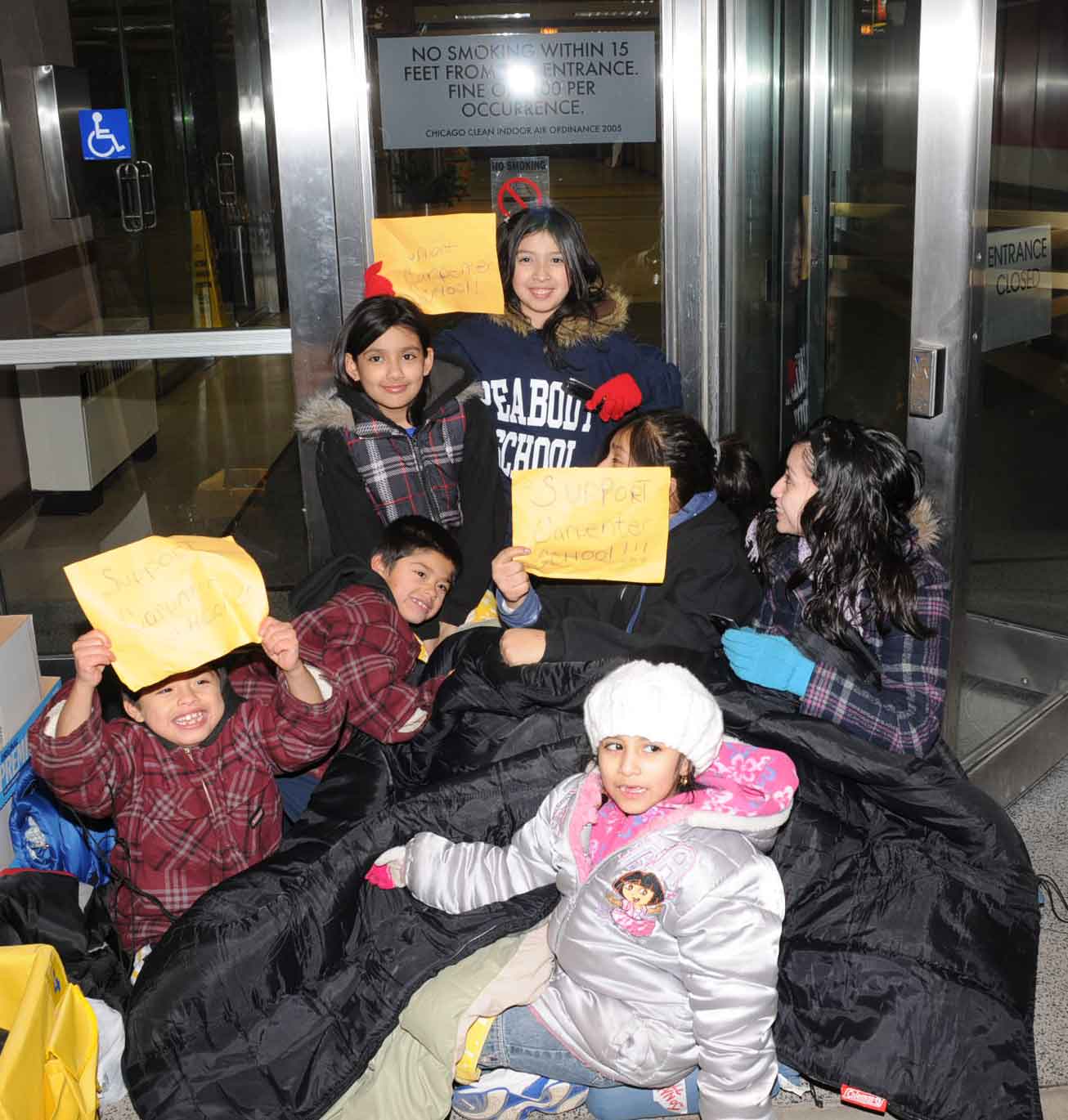 Children from Chicago's Peabody Elementary School settled in for the all-night protest vigil against "Renaissance 2010" in front of the headquarters of the Chicago Board of Education at 125 S. Clark St. The children and their parents had joined the protest even though Peabody School was one of six that were taken off the "Hit List" of 22 schools the night before by Chicago Schools CEO Ron Huberman. Teachers, parents, and children from two of the schools that had been granted a reprieve from the threats against them joined parents, teachers, and community supporters from the 16 schools still on the "Hit List" for the all-night vigil. Substance photo by George N. Schmidt.The protesters had been gathering for an all-night vigil demanding a moratorium on school closings, turnarounds, phase outs, and consolidations.
Children from Chicago's Peabody Elementary School settled in for the all-night protest vigil against "Renaissance 2010" in front of the headquarters of the Chicago Board of Education at 125 S. Clark St. The children and their parents had joined the protest even though Peabody School was one of six that were taken off the "Hit List" of 22 schools the night before by Chicago Schools CEO Ron Huberman. Teachers, parents, and children from two of the schools that had been granted a reprieve from the threats against them joined parents, teachers, and community supporters from the 16 schools still on the "Hit List" for the all-night vigil. Substance photo by George N. Schmidt.The protesters had been gathering for an all-night vigil demanding a moratorium on school closings, turnarounds, phase outs, and consolidations.
"We'll give you six tents, then," said Sgt Easterday, of the First Police District, who had been called after the protesters began setting up tents for the all-night protest as the temperature along windy Clark St. dropped below freezing.
Sgt. Easterday and Sgt. Engstron had been sent to the front of the headquarters of the Chicago Board of Education after someone complained that the protesters were setting up tents. The protesters -- who numbered more than 50 by 8:30 p.m. -- began setting up the tents to spend the night in front of the headquarters of the third largest school system in the USA. The event was part of a growing movement in Chicago against the controversial program of replacing public schools with privatized charter schools and other types of experimental alternatives to traditional public schools.
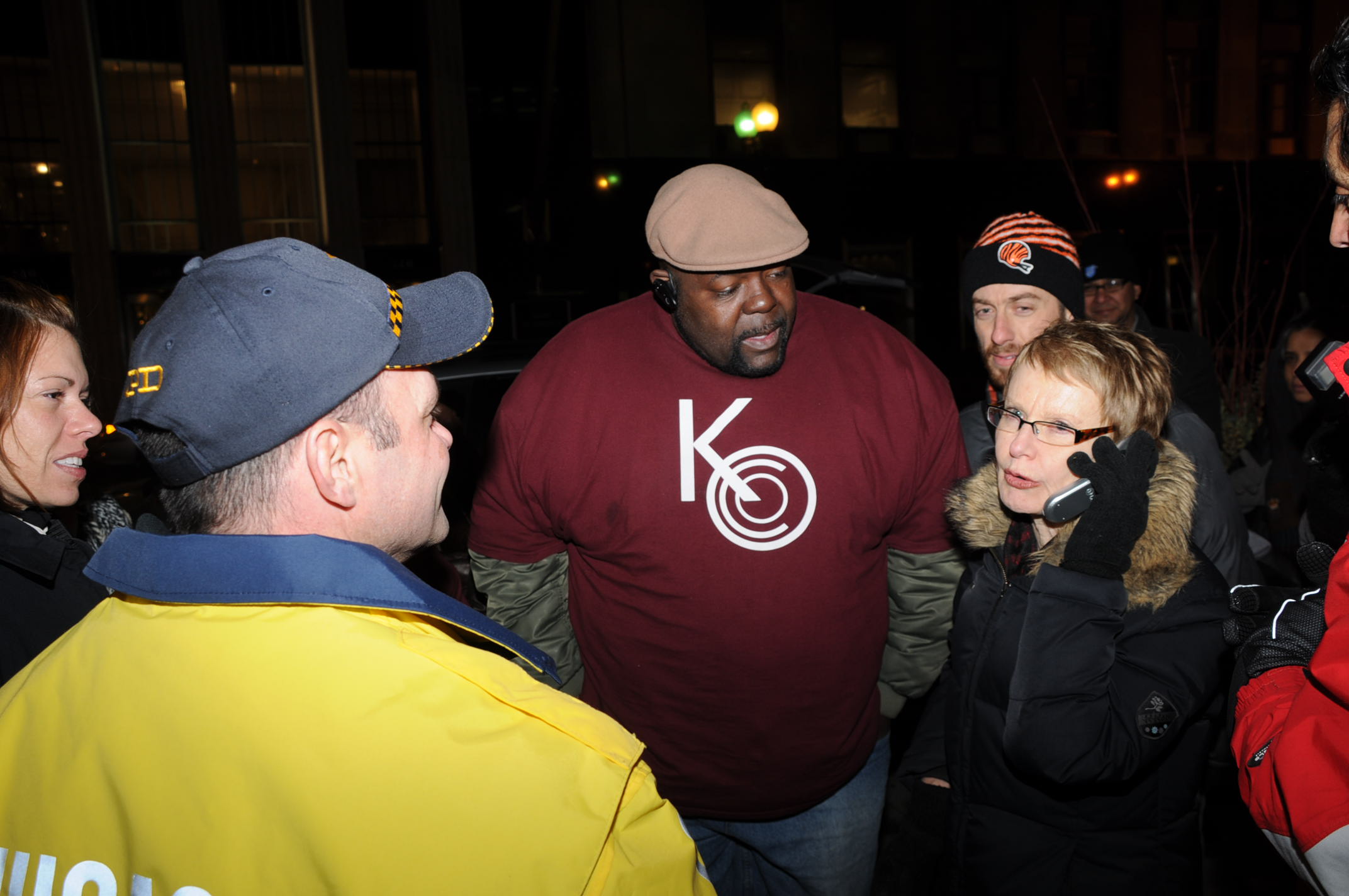 February 24, 2009. Chicago Police and leaders of the Grassroots Education Movement (GEM) complete negotiations over whether protesters can put tents along Clark St. in Chicago outside the headquarters of the Chicago Board of Education. After some discussion, police agreed that the protesters could have six tents along the sidewalk for the cold night. Above (left to right) Chicago Police Sgt. Engstron, Chicago Police Sgt. Easterday, Jitu Brown (Kenwood Oakland Community Organization), Jackson Potter (CORE), and Pauline Lipman (Teachers for Social Justice). Substance photo by George N. Schmidt.At 9:00 p.m. the temperature had dropped to the freezing mark, but a number of the protesters cheered when they were told by protest organizers that the Police had agreed to allow the tents the protesters had brought.
February 24, 2009. Chicago Police and leaders of the Grassroots Education Movement (GEM) complete negotiations over whether protesters can put tents along Clark St. in Chicago outside the headquarters of the Chicago Board of Education. After some discussion, police agreed that the protesters could have six tents along the sidewalk for the cold night. Above (left to right) Chicago Police Sgt. Engstron, Chicago Police Sgt. Easterday, Jitu Brown (Kenwood Oakland Community Organization), Jackson Potter (CORE), and Pauline Lipman (Teachers for Social Justice). Substance photo by George N. Schmidt.At 9:00 p.m. the temperature had dropped to the freezing mark, but a number of the protesters cheered when they were told by protest organizers that the Police had agreed to allow the tents the protesters had brought.
The protests, which had been growing for more than one month, were demanding that the Board of Education stop all actions against Chicago's remaining public schools under the so-called "Renaissance 2010" plan initiated by Chicago Mayor Richard M. Daley in 2004. Renaissance 2010 has resulted in the closing of more than 50 public schools in Chicago since 2002, when the first closings began shortly after Arne Duncan was appointed Chief Executive Officer of the 410,000-student school system in July 2001.
Candlelight vigil, preparation for large protests at Chicago Board of Education meeting
The evening began shortly after seven o'clock with a candlelight vigil in front of a banner demanding an end to Renaissance 2010. The vigil was one of several held over the past three days and nights as the day drew near when the Chicago Board of Education would vote on the latest round of public school closings, consolidations, phase outs, and so-called "turnarounds" under the controversial "Renaissance 2010" program.
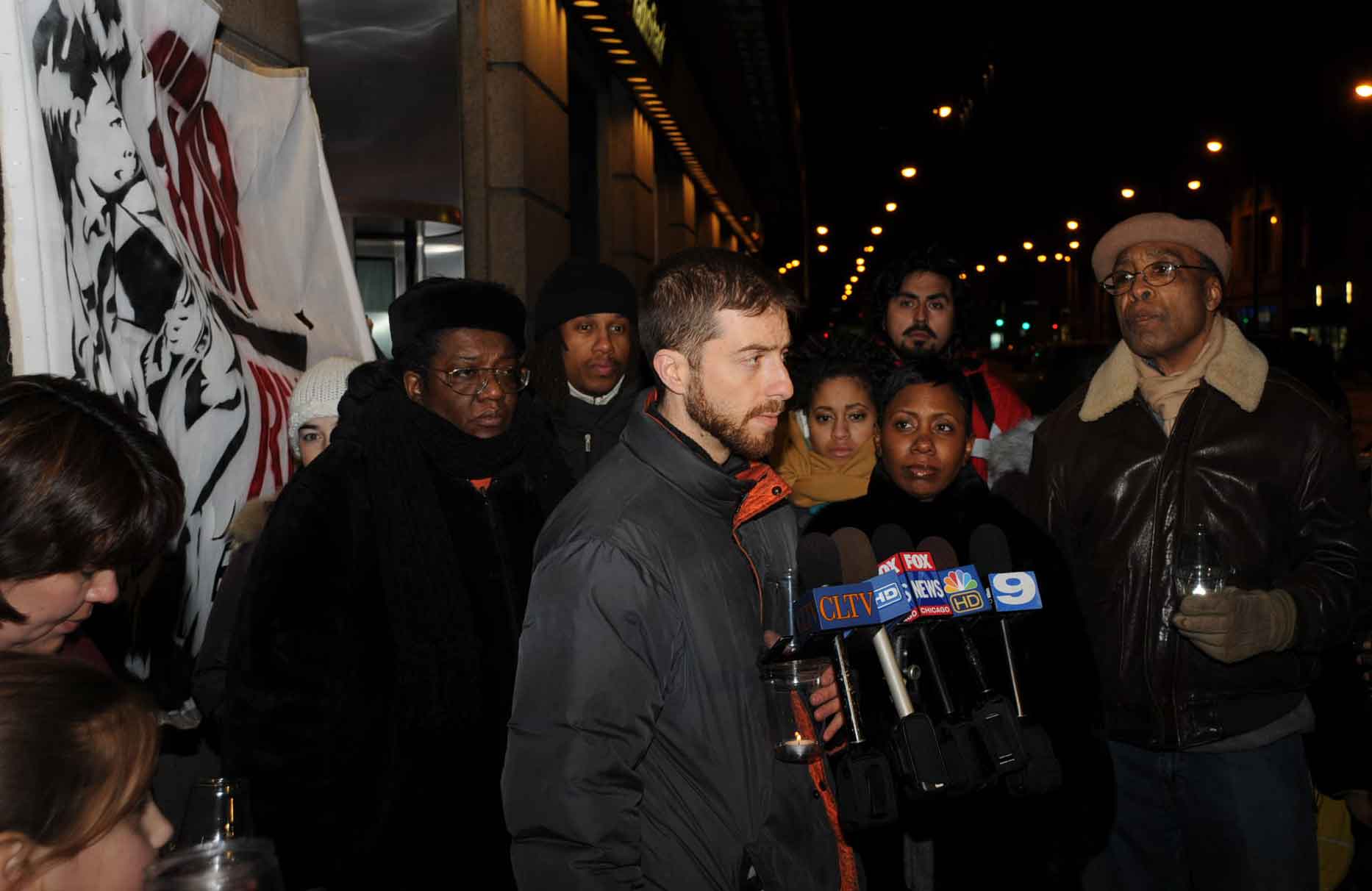 Little Village High School teacher Jackson Potter, a leader of CORE (the Caucus of Rank-and-file Educators) and a Chicago Teachers Union delegate, told reporters and protesters that the protests would continue until the entire 'Hit List' of all 22 schools was stopped. The night before the February 24 protest, CPS officials had announced that six of the original 22 schools had been taken off the list. Substance photo by George N. Schmidt.By 7:30 p.m., representatives of several schools and organizations spoke with the media, including reporters from five TV stations.
Little Village High School teacher Jackson Potter, a leader of CORE (the Caucus of Rank-and-file Educators) and a Chicago Teachers Union delegate, told reporters and protesters that the protests would continue until the entire 'Hit List' of all 22 schools was stopped. The night before the February 24 protest, CPS officials had announced that six of the original 22 schools had been taken off the list. Substance photo by George N. Schmidt.By 7:30 p.m., representatives of several schools and organizations spoke with the media, including reporters from five TV stations.
As the numbers of protesters grew, it became clear that the night would draw a significant number of people. At around 8:00 p.m., more than a dozen people arrived from Peabody Elementary School, to loud cheers. Peabody had been on the original "hit list" of 22 schools but had been taken off the day before.
"We had to come to show solidarity with our brothers and sisters from other schools, especially out neighbors from Carpenter," said Lillie Gonzalez, a Peabody grandmother who speaks proudly about the three generations of her family who have attended the neighborhood elementary school.
Another school that had been spared this year's round of cuts was also represented. Teachers and children from Holmes Elementary were helping set up the candles as the night began.
Demand end to entire 'Hit List'
During an early press conference organized by GEM, speakers stated that there would be large protests on February 25 demanding that all 22 school slated for Renaissance 2010 changes this year be taken off the 'Hit List'. Organized protests against Renaissance 2010 scheduled for February 25 include dozens of people planning to speak out against the program and other activities. The Chicago Teachers Union is helping organize a major march from CPS headquarters to the Thompson Center against Renaissance 2010 and in favor of legislation sponsored by Illinois State Rep. Cynthia Soto demanding a moratorium on these radical changes which have become the hallmark of the program. The CTU has also asked all teachers and other school workers to wear black all day on the day of the Board of Education meeting. CORE, a caucus within the Chicago Teachers Union, has catalyzed much of the protest over the past three months. Planning in advance to challenge the school closings and other radical changes and knowing that February is usually the month when the Board votes on the changes, CORE members began organizing in December. A speak out against Renaissance 2010 and the sabotage of Chicago's neighborhood public schools took place at the Board's December 17, 2008 meeting. The speak out was held the day after President Barack Obama announced that he was appointing Chicago's Arne Duncan, a major architect of Renaissance 2010, to the post of U.S. Secretary of Education.
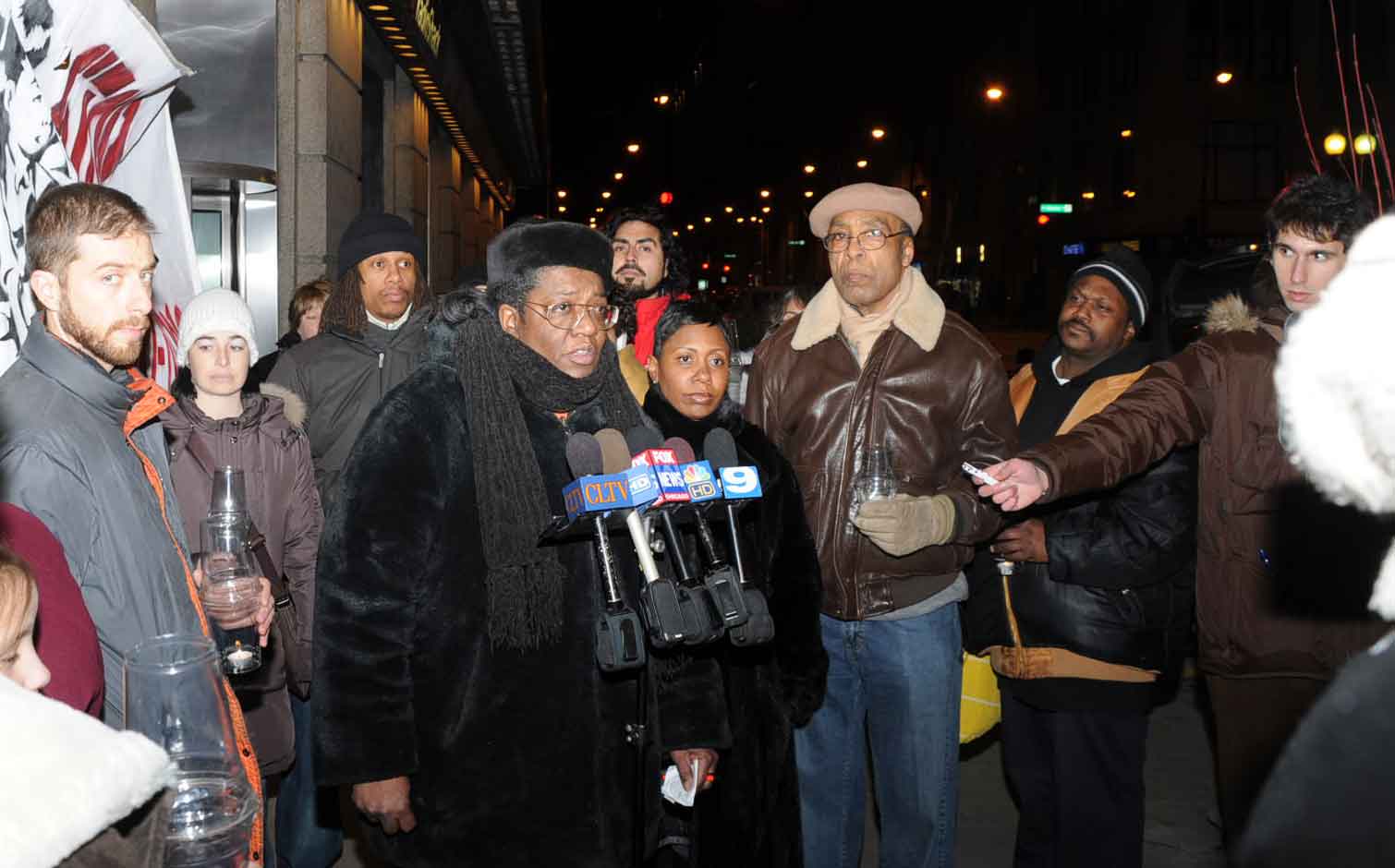 Above, Wanda Hopkins of PURE (People United for Responsible Education) talks about the need to stop Renaissance 2010. PURE has been organizing against the program since it was begun as a massive privatization plan by former Chicago schools CEO Arne Duncan (now U.S. Secretary of Education) more than six years ago. Substance photo by George N. Schmidt.The December protest was followed by a significant forum at Chicago's Malcolm X College on January 10. Despite a major snow storm, more than 500 people attended the event, organized by CORE and co-sponsored by the Chicago Teachers Union and other groups. After the January 10 event at Malcolm X, focus was on organizing the schools on the 'Hit List' itself. On January 26, hearings began on the proposed closings, consolidations, phase outs, and "turnarounds" of 22 schools. CORE members attended all of the hearings and reported on many of them here at Substancenews.net.
Above, Wanda Hopkins of PURE (People United for Responsible Education) talks about the need to stop Renaissance 2010. PURE has been organizing against the program since it was begun as a massive privatization plan by former Chicago schools CEO Arne Duncan (now U.S. Secretary of Education) more than six years ago. Substance photo by George N. Schmidt.The December protest was followed by a significant forum at Chicago's Malcolm X College on January 10. Despite a major snow storm, more than 500 people attended the event, organized by CORE and co-sponsored by the Chicago Teachers Union and other groups. After the January 10 event at Malcolm X, focus was on organizing the schools on the 'Hit List' itself. On January 26, hearings began on the proposed closings, consolidations, phase outs, and "turnarounds" of 22 schools. CORE members attended all of the hearings and reported on many of them here at Substancenews.net.
Major protests were held during and after the January 28 Chicago Board of Education meeting.
Political leaders begin to help
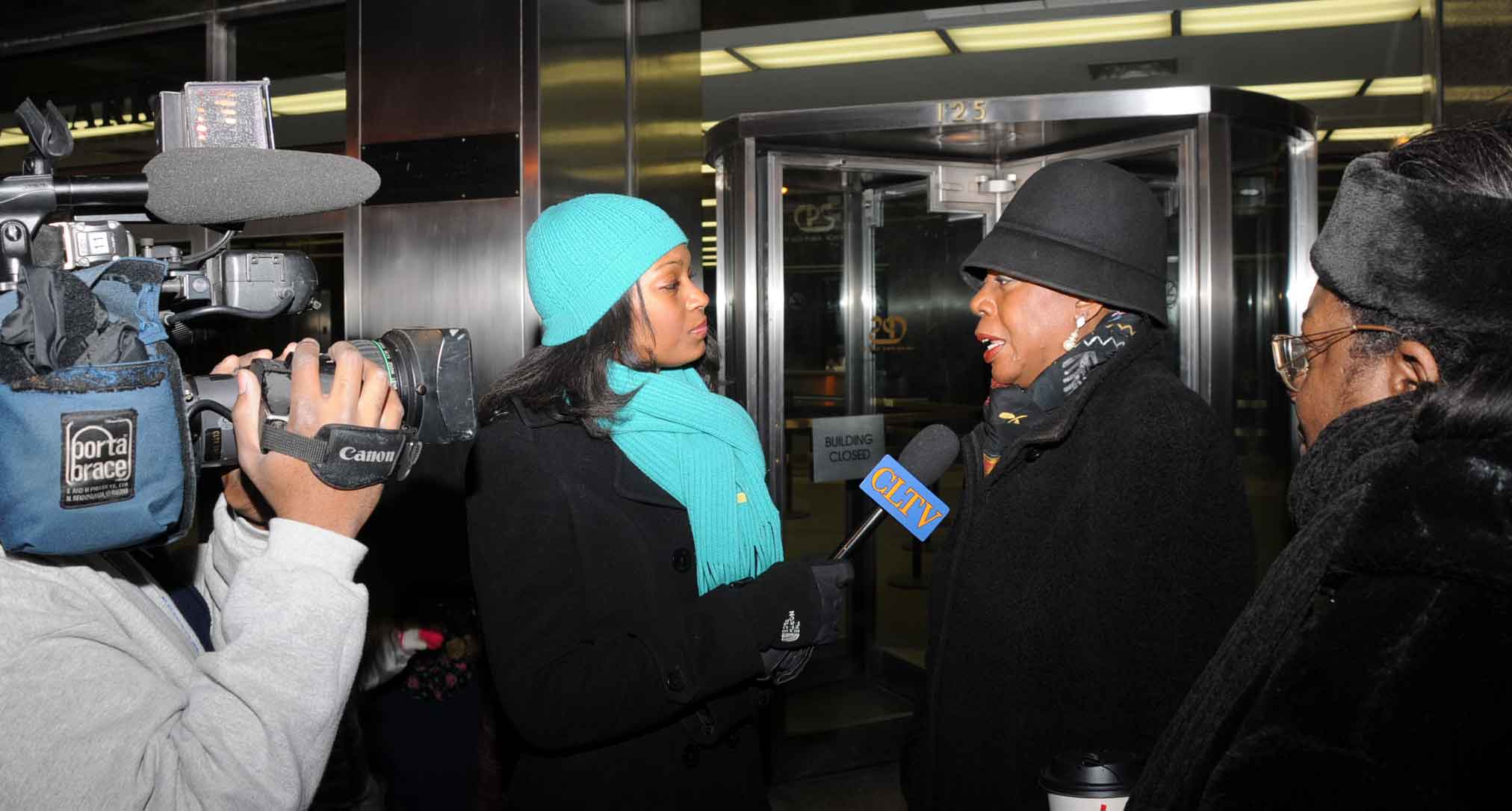 Cook County Clerk of the Court Dorothy Brown (second from right) joined the protesters at the school board's offices and spoke to the press about her support for the moratorium on school closings, phase outs, turnarounds, and consolidations under Renaissance 2010. Despite lack of support from organized labor, which had promised it and then backed away from a confrontation with Mayor Richard M. Daley, Brown ran strongly across the city in the 2007 mayoral election, drawing a significant number of votes in many wards that are overwhelmingly white. Substance photo by George N. Schmidt.By mid-February, a growing number of political leaders were supporting the protests and joining in the demand that Renaissance 2010 be stopped. On February 24, one of the visitors to the vigil was Dorothy Brown, Clerk of the Circuit Court of Cook County, the largest court system in the USA.
Cook County Clerk of the Court Dorothy Brown (second from right) joined the protesters at the school board's offices and spoke to the press about her support for the moratorium on school closings, phase outs, turnarounds, and consolidations under Renaissance 2010. Despite lack of support from organized labor, which had promised it and then backed away from a confrontation with Mayor Richard M. Daley, Brown ran strongly across the city in the 2007 mayoral election, drawing a significant number of votes in many wards that are overwhelmingly white. Substance photo by George N. Schmidt.By mid-February, a growing number of political leaders were supporting the protests and joining in the demand that Renaissance 2010 be stopped. On February 24, one of the visitors to the vigil was Dorothy Brown, Clerk of the Circuit Court of Cook County, the largest court system in the USA.
THIS ARTICLE WILL BE UPDATED THROUGHOUT THE NIGHT OF FEBRUARY 24, 2009

